Label: SOOLANTRA- ivermectin cream
-
NDC Code(s):
0299-3823-00,
0299-3823-02,
0299-3823-30,
0299-3823-45, view more0299-3823-60
- Packager: Galderma Laboratories, L.P.
- Category: HUMAN PRESCRIPTION DRUG LABEL
- DEA Schedule: None
- Marketing Status: New Drug Application
Drug Label Information
Updated October 24, 2024
If you are a consumer or patient please visit this version.
- Download DRUG LABEL INFO: PDF XML
- Official Label (Printer Friendly)
-
HIGHLIGHTS OF PRESCRIBING INFORMATION
These highlights do not include all the information needed to use SOOLANTRA Cream safely and effectively. See full prescribing information for SOOLANTRA Cream.
SOOLANTRA ®(ivermectin) cream, 1%, for topical use
Initial U.S. Approval: 1996INDICATIONS AND USAGE
SOOLANTRA cream is indicated for the treatment of inflammatory lesions of rosacea. ( 1)
DOSAGE AND ADMINISTRATION
DOSAGE FORMS AND STRENGTHS
Cream, 1% ( 3)
CONTRAINDICATIONS
None. ( 4)
ADVERSE REACTIONS
In controlled clinical trials with SOOLANTRA cream the most common adverse reactions (incidence ≤ 1 %) included skin burning sensation and skin irritation. (6.1) (5)
To report SUSPECTED ADVERSE REACTIONS, contact Galderma Laboratories, L.P. at 1-866-735-4137 or FDA at 1-800-FDA-1088 or www.fda.gov/medwatch. (5)
See 17 for PATIENT COUNSELING INFORMATION.
Revised: 10/2022
-
Table of Contents
FULL PRESCRIBING INFORMATION: CONTENTS*
1 INDICATIONS AND USAGE
2 DOSAGE AND ADMINISTRATION
3 DOSAGE FORMS AND STRENGTHS
4 CONTRAINDICATIONS
6 ADVERSE REACTIONS
6.1 Clinical Trials Experience
6.2 Postmarketing Experience
7 DRUG INTERACTIONS
8 USE IN SPECIFIC POPULATIONS
8.1 Pregnancy
8.2 Lactation
8.4 Pediatric Use
8.5 Geriatric Use
10 OVERDOSAGE
11 DESCRIPTION
12 CLINICAL PHARMACOLOGY
12.1 Mechanism of Action
12.2 Pharmacodynamics
12.3 Pharmacokinetics
13 NONCLINICAL TOXICOLOGY
13.1 Carcinogenesis, Mutagenesis, Impairment of Fertility
14 CLINICAL STUDIES
16 HOW SUPPLIED/STORAGE AND HANDLING
17 PATIENT COUNSELING INFORMATION
- *
- Sections or subsections omitted from the full prescribing information are not listed.
- 1 INDICATIONS AND USAGE
- 2 DOSAGE AND ADMINISTRATION
- 3 DOSAGE FORMS AND STRENGTHS
- 4 CONTRAINDICATIONS
-
6 ADVERSE REACTIONS
6.1 Clinical Trials Experience
Because clinical trials are conducted under widely varying conditions, adverse reaction rates observed in the clinical trials of a drug cannot be directly compared to rates in the clinical trials of another drug and may not reflect the rates observed in practice.
During clinical trials, 2047 subjects with inflammatory lesions of rosacea received SOOLANTRA cream once daily. A total of 1555 subjects were treated once daily for more than 12 weeks, and 519 for approximately one year.
Adverse reactions, reported in ≤ 1% of subjects treated with SOOLANTRA cream for at least 3 months in vehicle-controlled clinical trials, included skin burning sensation and skin irritation.
6.2 Postmarketing Experience
Because adverse reactions are reported voluntarily from a population of uncertain size, it is not always possible to reliably estimate their frequency or establish a causal relationship to drug exposure.
Local adverse reactions: contact dermatitis and allergic dermatitis.
- 7 DRUG INTERACTIONS
-
8 USE IN SPECIFIC POPULATIONS
8.1 Pregnancy
Risk Summary
The available data on the use of ivermectin, including SOOLANTRA cream, in pregnant women are insufficient to establish a drug- associated risk of major birth defects, miscarriage, or adverse maternal or fetal outcomes.
In animal reproduction studies, ivermectin induced adverse developmental outcomes when orally administered to pregnant rats and rabbits during the period of organogenesis at doses 1909 or 354 times the maximum recommended human dose (MRHD), respectively. These orally administered doses were maternally toxic to pregnant rats and rabbits. In a pre-and postnatal developmental study in rats, neonatal toxicity and adverse effects on behavioral development were observed when ivermectin was orally administered to pregnant females during gestation and lactation (see Data).
The background risk of major birth defects and miscarriage for the indicated population is unknown. All pregnancies have a background risk of birth defect, loss, or other adverse outcomes. In the U.S. general population, the estimated background risk of major birth defects and miscarriage in clinically recognized pregnancies is 2 to 4% and 15 to 20%, respectively.Data
Human Data
No adequate and well-controlled trials of Soolantra cream have been conducted in pregnant women. Retrospective observational studies evaluated pregnancy outcomes in over 700 women in various stages of pregnancy who received oral ivermectin for the treatment of soil-transmitted helminths in rural Africa. In an additional, randomized open-label trial, 397 pregnant women in their second trimester received a single dose of oral ivermectin, or ivermectin plus albendazole, for soil-transmitted helminths. When compared with a pregnant, untreated population, no differences in pregnancy outcomes were observed between the treated and untreated populations. These studies cannot definitively establish or exclude any drug-associated risk during pregnancy, because either the timing of administration during gestation was not accurately ascertained or the administration occurred only during the second trimester.Animal Data
Systemic embryofetal development studies were conducted in rats and rabbits. Oral doses of 1.5, 4, and 12mg/kg/day ivermectin were administered during the period of organogenesis to pregnant female rats. Maternal death occurred at 12 mg/kg/day [1909 times the MRHD based on area under the curve (AUC) comparison]. Cleft palate occurred in the fetuses from the 12 mg/kg/day (1909 times the MRHD based on AUC comparison) group. No treatment related embryofetal toxicity or malformations were noted at 4 mg/kg/day (708 times the MRHD based on AUC comparison). Oral doses of 0.5, 1.5, 2.5, 3.5 and 4.5 mg/kg/day ivermectin were administered during the period of organogenesis to pregnant female rabbits. Maternal death occurred at doses ≥ 2.5 mg/kg/day (72 times the MRHD based on AUC comparison). Carpal flexure occurred in the fetuses from the 4.5 mg/kg/day (354 times the MRHD based on AUC comparison) group. Fetal weight decrease was noted at 3.5 mg/kg/day (146 times the MRHD based on AUC comparison). No treatment related embryofetal toxicity or malformations were noted at 2.5 mg/kg/day (72 times the MRHD based on AUC comparison).
A pre- and postnatal development study was conducted in rats. Oral doses of 1, 2 and 4 mg/kg/day ivermectin were administered to pregnant female rats during gestational days 6-20 and lactation days 2-20. Neonatal death occurred at doses ≥ 2 mg/kg/day. Behavior development of newborn rats was adversely affected at all doses.8.2 Lactation
Risk Summary
The presence of ivermectin in human milk following topical administration of ivermectin has not been evaluated. There are no data available regarding the effects of ivermectin on milk production. Published literature suggests that ivermectin was detectable in human milk in 4 lactating women after a single 150 mcg/kg oral dose of ivermectin. However, there is insufficient information from this report to determine the effects of ivermectin on the breastfed infant. The developmental and health benefits of breastfeeding should be considered along with the mother’s clinical need for Soolantra cream and any potential adverse effects on the breastfed infant from Soolantra cream or from the underlying maternal conditions.8.4 Pediatric Use
Safety and effectiveness of SOOLANTRA cream in pediatric patients have not been established.
8.5 Geriatric Use
Of the 1371 subjects in the two pivotal clinical studies of SOOLANTRA cream, 170 (12.4%) were 65 and over, while 37 (2.7%) were 75 and over. No overall differences in safety or effectiveness were observed between these subjects and younger subjects, and other reported clinical experience has not identified differences in responses between the elderly and younger patients, but greater sensitivity of some older individuals cannot be ruled out.
-
10 OVERDOSAGE
In accidental or significant exposure to unknown quantities of veterinary formulations of ivermectin in humans, either by ingestion, inhalation, injection, or exposure to body surfaces, the following adverse effects have been reported most frequently: rash, edema, headache, dizziness, asthenia, nausea, vomiting, and diarrhea. Other adverse effects that have been reported include: seizure, ataxia, dyspnea, abdominal pain, paresthesia, urticaria, and contact dermatitis.
In case of accidental ingestion, supportive therapy, if indicated, should include parenteral fluids and electrolytes, respiratory support (oxygen and mechanical ventilation if necessary) and pressor agents if clinically significant hypotension is present. Induction of emesis and/or gastric lavage as soon as possible, followed by purgatives and other routine anti-poison measures, may be indicated if needed to prevent absorption of ingested material.
-
11 DESCRIPTION
SOOLANTRA (ivermectin) cream, 1% is a white to pale yellow hydrophilic cream intended for topical use. Each gram of SOOLANTRA cream contains 10 mg of ivermectin.
Ivermectin is a semi-synthetic derivative isolated from the fermentation of Streptomyces avermitilis that belongs to the avermectin family of macrocyclic lactones.
Ivermectin is a mixture containing not less than 95.0% and not more than 102.0% of 5-O-demethyl-22,23-dihydroavermectin A 1aplus 5-O-demethyl-25-de(1-methylpropyl)-25-(1-methylethyl)-22,23-dihydroavermectin A 1a, generally referred to as 22,23-dihydroavermectin B 1aand B 1bor H 2B 1aand H 2B 1b, respectively; and the ratio (calculated by area percentage) of component H 2B 1a/(H 2B 1a+ H 2B 1b) is not less than 90.0%.
The respective empirical formulas of H 2B 1aand H 2B 1bare C 48H 74O 14and C 47H 72O 14with molecular weights of 875.10 and 861.07 respectively.The structural formulas are:
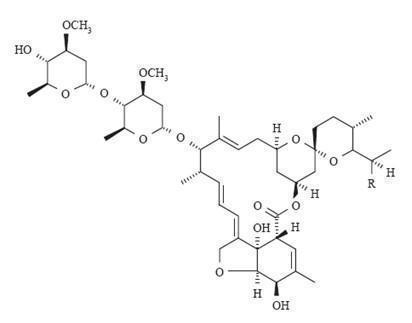
Component H 2B 1a: R = C 2H 5, Component H 2B 1b: R = CH 3.
SOOLANTRA cream contains the following inactive ingredients: carbomer copolymer type B, cetyl alcohol, citric acid monohydrate, dimethicone, edetate disodium, glycerin, isopropyl palmitate, methylparaben, oleyl alcohol, phenoxyethanol, polyoxyl 20 cetostearyl ether, propylene glycol, propylparaben, purified water, sodium hydroxide, sorbitan monostearate, and stearyl alcohol.
-
12 CLINICAL PHARMACOLOGY
12.1 Mechanism of Action
The mechanism of action of SOOLANTRA cream in treating rosacea lesions is unknown.
12.2 Pharmacodynamics
Cardiac Electrophysiology
At therapeutic doses, SOOLANTRA cream is not expected to prolong QTc interval.12.3 Pharmacokinetics
Absorption
The absorption of ivermectin from SOOLANTRA cream was evaluated in a clinical trial in 15 adult male and female subjects with severe papulopustular rosacea applying 1 g SOOLANTRA cream, 1% once daily. At steady state (after 2 weeks of treatment), the highest mean ± standard deviation plasma concentrations of ivermectin peaked (T max) at 10 ± 8 hours post dose, the maximum concentration (C max) was 2.10 ± 1.04 ng/mL (range: 0.69 - 4.02 ng/mL) and the area under the concentration curve (AUC 0-24hr) was 36.14 ± 15.56 ng.hr/mL (range: 13.69-75.16 ng.hr/mL). In addition, systemic exposure assessment in longer treatment duration (Phase 3 studies) showed that there was no plasma accumulation of ivermectin over the 52-week treatment period.Distribution
An in vitro study demonstrated that ivermectin is greater than 99% bound to plasma proteins and is bound primarily to human serum albumin. No significant binding of ivermectin to erythrocytes was observed.Metabolism
In vitro studies using human hepatic microsomes and recombinant CYP450 enzymes have shown that ivermectin is primarily metabolized by CYP3A4. In vitro studies show that ivermectin at therapeutic concentrations does not inhibit the CYP450 isoenzymes 1A2, 2A6, 2B6, 2C8, 2C9, 2C19, 2D6, 2E1, 3A4 or 4A11, or induce 1A2, 2B6, 2C9 or 3A4.Excretion
The apparent terminal half-life averaged 6.5 days (mean ± standard deviation: 155± 40 hours, range 92-238 hours) in patients receiving a once daily cutaneous application of SOOLANTRA cream for 28 days. -
13 NONCLINICAL TOXICOLOGY
13.1 Carcinogenesis, Mutagenesis, Impairment of Fertility
In a 2-year dermal mouse carcinogenicity study, ivermectin was administered to CD-1 mice at topical doses of 1, 3, and 10 mg/kg/day (0.1%, 0.3% and 1% ivermectin cream applied at 2 ml/kg/day). No drug-related tumors were noted in this study up to the highest dose evaluated in this study of 10 mg/kg/day (747 times the MRHD based on AUC comparison).
In a 2-year oral rat carcinogenicity study, ivermectin was administered to Wistar rats at gavage doses of 1, 3, and 9 mg/kg/day. A statistically significant increase in the incidence of hepatocellular adenoma was noted in males treated with 9 mg/kg/day (1766 times the MRHD based on AUC comparison) ivermectin. The clinical relevance of this finding is unknown. No drug-related tumors were noted in females up to the highest dose evaluated in this study of 9 mg/kg/day (1959 times the MRHD based on AUC comparison). No drug-related tumors were noted in males at doses ≤ 3 mg/kg/day (599 times the MRHD based on AUC comparison).
Ivermectin revealed no evidence of genotoxic potential based on the results of two in vitro genotoxicity tests (the Ames test and the L5178Y/TK +/-mouse lymphoma assay) and one in vivo genotoxicity test (rat micronucleus assay).
In a fertility study, oral doses of 0.1, 1 and 9 mg/kg/day ivermectin were administered to male and female rats. Mortality occurred at 9 mg/kg/day (1027 times the MRHD based on AUC comparison). The precoital period was generally prolonged at 9 mg/kg/day. No treatment-related effects on fertility or mating performance were noted at doses ≤ 1 mg/kg/day (68 times the MRHD based on AUC comparison).
-
14 CLINICAL STUDIES
SOOLANTRA cream applied once daily at bedtime was evaluated in the treatment of inflammatory lesions of rosacea in two randomized, double-blind, vehicle controlled clinical trials, which were identical in design. The trials were conducted in 1371 subjects aged 18 years and older who were treated once daily for 12 weeks with either SOOLANTRA cream or vehicle cream.
Overall, 96% of subjects were Caucasian and 67% were female. Using the 5-point Investigator Global Assessment (IGA) scale (0=clear, 1=almost clear, 2=mild, 3=moderate, 4=severe), 79% of subjects were scored as moderate (IGA=3) and 21% scored as severe (IGA= 4) at baseline.
The co-primary efficacy endpoints in both pivotal trials were the success rate based on the IGA outcome (percentage of subjects “clear” and “almost clear”) and absolute change from baseline in inflammatory lesion counts at Week 12. Table 1 presents the co-primary efficacy results at Week 12. SOOLANTRA cream was more effective than vehicle cream on the co-primary efficacy endpoints starting from 4 weeks of treatment in both studies, see Figures 1 through 4.
Table 1: Co-Primary Efficacy Results at Week 12 Study 1 Study 2 SOOLANTRA Vehicle
Cream (N=451) Cream (N=232)
SOOLANTRA Vehicle
Cream (N=459) Cream (N=229)Investigator Global Assessment:
Number (%) of Subjects Clear or Almost Clear
173 (38.4%) 27 (11.6%) 184 (40.1%) 43 (18.8%) Inflammatory Lesion Counts:
Mean Absolute (%) Change from Baseline20.5 (64.9%) 12.0 (41.6%) 22.2 (65.7%) 13.4 (43.4%) Figures 1 and 2: IGA Success Rates Over Time
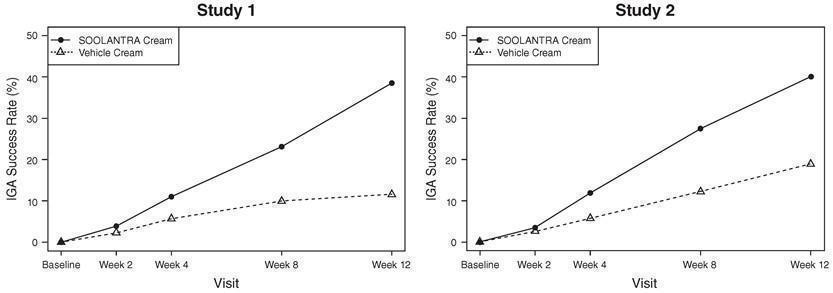
Figures 3 and 4: Mean Absolute Change in Inflammatory Lesion Counts from Baseline Over Time
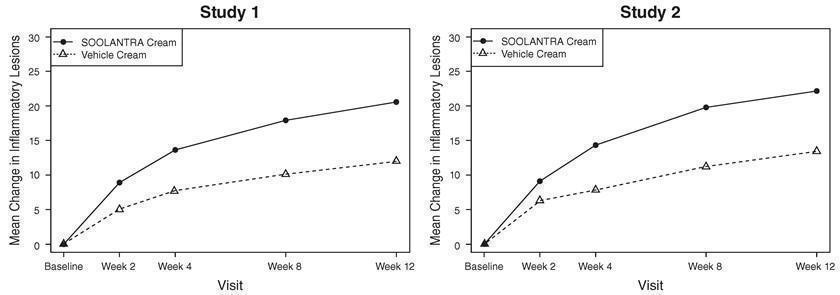
-
16 HOW SUPPLIED/STORAGE AND HANDLING
SOOLANTRA (ivermectin) cream, 1% is a white to pale yellow cream, supplied in a laminated tube with a child resistant cap in the following sizes:
30 gram NDC0299-3823-30
45 gram NDC0299-3823-45
60 gram NDC0299-3823-60
Storage
Store at 20°C to 25°C (68°F to 77°F), excursions permitted between 15°C and 30°C (59°F and 86°F) [See USP Controlled Room Temperature]. -
17 PATIENT COUNSELING INFORMATION
Advise the patient to read the FDA-approved patient labeling (Instructions for Use).
Patients using SOOLANTRA cream should receive the following instruction:
Keep out of reach of children.
Marketed by:
GALDERMA LABORATORIES, L.P.
Dallas, Texas 75201 USAMade in Canada.
P52476-3
Instructions for Use
SOOLANTRA® (SOO-LAWN-TRAH)
(ivermectin) creamImportant: SOOLANTRA cream is for use on the skin only (topical use). Do not use SOOLANTRA cream in your eyes, mouth or vagina.
Read and follow the steps below so that you use SOOLANTRA cream correctly:
1. Open the tube of SOOLANTRA cream by gently pressing down on the child resistant cap and twist in the direction of the arrow (counterclockwise) as shown below. See Figures A and B. To avoid spilling, do not squeeze the tube while opening or closing.

2. To apply SOOLANTRA cream to your face, squeeze a pea-sized amount of SOOLANTRA cream from the tube onto your fingertip. See Figure C.
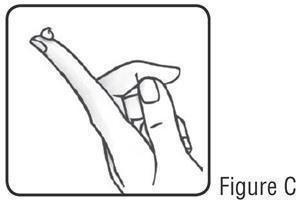
3. Apply SOOLANTRA to the affected areas of your face 1 time a day. Use a pea-sized amount of SOOLANTRA cream for each area of your face (forehead, chin, nose, each cheek) that is affected. Spread the cream smoothly and evenly in a thin layer. Avoid contact with your eyes and lips.
4. To close SOOLANTRA cream, gently press down on the child resistant cap and twist to the right (clockwise). See Figure D.
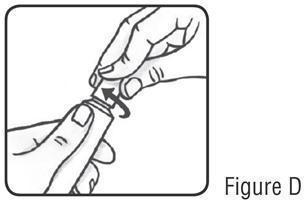
How should I store SOOLANTRA cream?
- Store SOOLANTRA cream at room temperature between 68°F to 77°F (20°C to 25°C).
Keep SOOLANTRA cream and all medicines out of the reach of children.
Marketed by: GALDERMA LABORATORIES, L.P. Dallas, TX 75201 USA
P52476-3
Made in Canada.
This Instructions for Use has been approved by the U.S. Food and Drug Administration. Revised:10/2022 -
PATIENT INFORMATION
SOOLANTRA® (SOO-LAWN-TRAH)
(ivermectin) creamImportant: SOOLANTRA cream is for use on the skin only (topical use).Do not use SOOLANTRA cream in your mouth, eyes, or vagina.
What is SOOLANTRA cream?
SOOLANTRA cream is a prescription medicine used on the skin (topical) to treat pimples and bumps (inflammatory lesions) caused by a condition called rosacea.
It is not known if SOOLANTRA cream is safe and effective in children.Before using SOOLANTRA cream, tell your healthcare provider about all your medical conditions, including if you:
- are pregnant or plan to become pregnant. It is not known if SOOLANTRA cream will harm your unborn baby.
- are breastfeeding or plan to breastfeed. It is not known if SOOLANTRA cream passes into your breast milk. Talk to your healthcare provider about the best way to feed your baby if you use SOOLANTRA cream.
Tell your healthcare provider about all of the medicines you take, including prescription and over-the-counter medicines, vitamins, and herbal supplements.
How should I use SOOLANTRA cream?
See the detailed “Instructions for Use” that comes with SOOLANTRA cream for information on how to apply SOOLANTRA cream.- Use SOOLANTRA cream exactly as your healthcare provider tells you to.
- Apply SOOLANTRA cream to the affected areas of your face 1 time a day.
- Avoid contact with your eyes and lips
- if SOOLANTRA cream is accidentally swallowed (ingested), call your healthcare provider or go to the nearest hospital emergency room right away.
What are the possible side effects of SOOLANTRA cream?
The most common side effects of SOOLANTRA cream includeskin burning sensation and skin irritation. These are not all of the possible side effects of SOOLANTRA cream.
Call your doctor for medical advice about side effects. You may report side effects to FDA at 1-800-FDA-1088.
You may also report side effects to Galderma Laboratories, L.P. at 1-866-735-4137.How should I store SOOLANTRA cream?
- Store SOOLANTRA cream at room temperature between 68°F to 77°F (20°C to 25°C).
Keep SOOLANTRA cream and all medicines out of the reach of children.
General information about the safe and effective use of SOOLANTRA cream.
Medicines are sometimes prescribed for purposes other than those listed in a Patient Information leaflet. Do not use SOOLANTRA cream for a condition for which it was not prescribed. Do not give SOOLANTRA cream to other people, even if they have the same symptoms that you have. It may harm them. You can ask your pharmacist or healthcare provider for information about SOOLANTRA cream that is written for health professionals.What are the ingredients in SOOLANTRA cream?
Active ingredient:ivermectin
Inactive ingredients:carbomer copolymer type B, cetyl alcohol, citric acid monohydrate, dimethicone, edetate disodium, glycerin, isopropyl palmitate, methylparaben, oleyl alcohol, phenoxyethanol, polyoxyl 20 cetostearyl ether, propylene glycol, propylparaben, purified water, sodium hydroxide, sorbitan monostearate, and stearyl alcohol.Marketed by: Galderma Laboratories, L.P., Dallas, Texas 75201 USA
P52476-3
Made in Canada
For more information about SOOLANTRA cream, call 1-866-735-4137.This Patient Information has been approved by the U.S. Food and Drug Administration. Issued: 10/2022
-
Package Label - 45 g
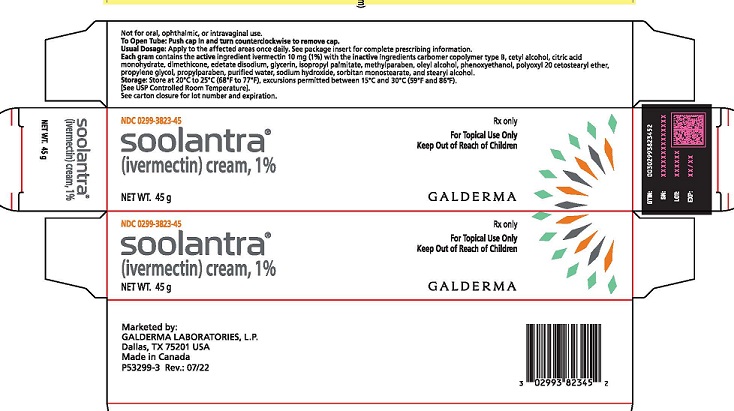
NDC 0299-3823-45
soolantra ®
(ivermectin) cream, 1%
NET WT. 45 g
Rx only
For Topical Use Only
Keep Out of Reach of Children
GALDERMA
Marketed by:
GALDERMA LABORATORIES, L.P.
Dallas, TX 75201 USA
Made in Canada
P53299-3 Rev: 07/22Not for oral, ophthalmic, or intravaginal use.
To Open Tube: Push cap in and turn counterclockwise to remove cap.
Usual Dosage: Apply to the affected areas once daily. See package insert for complete prescribing information.
Each gram contains the active ingredient ivermectin 10 mg (1%) with the inactive ingredients carbomer copolymer type B, cetyl alcohol, citric acid monohydrate, dimethicone, edetate disodium, glycerin, isopropyl palmitate, methylparaben, oleyl alcohol, phenoxyethanol, polyoxyl 20 cetostearyl ether, propylene glycol, propylparaben, purified water, sodium hydroxide, sorbitan monostearate, and stearyl alcohol.
Storage: Store at 20°C to 25°C (68°F to 77°F), excursions permitted between 15°C and 30°C (59°F and 86°F).
(See USP Controlled Room Temperature).
See carton closure for lot number and expiration. -
INGREDIENTS AND APPEARANCE
SOOLANTRA
ivermectin creamProduct Information Product Type HUMAN PRESCRIPTION DRUG Item Code (Source) NDC:0299-3823 Route of Administration TOPICAL Active Ingredient/Active Moiety Ingredient Name Basis of Strength Strength IVERMECTIN (UNII: 8883YP2R6D) (IVERMECTIN - UNII:8883YP2R6D) IVERMECTIN 10 mg in 1 g Inactive Ingredients Ingredient Name Strength CARBOMER COPOLYMER TYPE B (ALLYL PENTAERYTHRITOL CROSSLINKED) (UNII: 809Y72KV36) CETYL ALCOHOL (UNII: 936JST6JCN) CITRIC ACID MONOHYDRATE (UNII: 2968PHW8QP) DIMETHICONE (UNII: 92RU3N3Y1O) EDETATE DISODIUM (UNII: 7FLD91C86K) GLYCERIN (UNII: PDC6A3C0OX) ISOPROPYL PALMITATE (UNII: 8CRQ2TH63M) METHYLPARABEN (UNII: A2I8C7HI9T) OLEYL ALCOHOL (UNII: 172F2WN8DV) PHENOXYETHANOL (UNII: HIE492ZZ3T) POLYOXYL 20 CETOSTEARYL ETHER (UNII: YRC528SWUY) PROPYLENE GLYCOL (UNII: 6DC9Q167V3) PROPYLPARABEN (UNII: Z8IX2SC1OH) WATER (UNII: 059QF0KO0R) SODIUM HYDROXIDE (UNII: 55X04QC32I) SORBITAN MONOSTEARATE (UNII: NVZ4I0H58X) STEARYL ALCOHOL (UNII: 2KR89I4H1Y) Packaging # Item Code Package Description Marketing Start Date Marketing End Date 1 NDC:0299-3823-30 1 in 1 CARTON 01/01/2015 1 30 g in 1 TUBE; Type 0: Not a Combination Product 2 NDC:0299-3823-45 1 in 1 CARTON 01/01/2015 2 45 g in 1 TUBE; Type 0: Not a Combination Product 3 NDC:0299-3823-60 1 in 1 CARTON 01/01/2015 3 60 g in 1 TUBE; Type 0: Not a Combination Product 4 NDC:0299-3823-02 1 in 1 BLISTER PACK 01/01/2015 4 2 g in 1 TUBE; Type 0: Not a Combination Product 5 NDC:0299-3823-00 2 g in 1 TUBE; Type 0: Not a Combination Product 11/01/2019 Marketing Information Marketing Category Application Number or Monograph Citation Marketing Start Date Marketing End Date NDA NDA206255 01/01/2015 Labeler - Galderma Laboratories, L.P. (047350186) Registrant - Galderma Laboratories, L.P. (047350186) Establishment Name Address ID/FEI Business Operations G Production, Inc. 251676961 manufacture(0299-3823)

